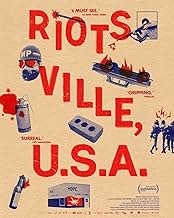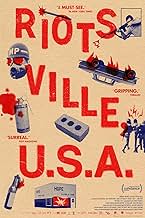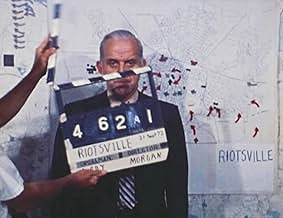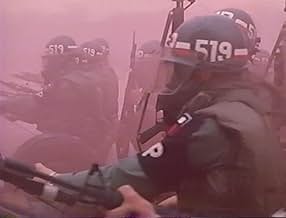Benvenuti a Riotsville, una città immaginaria costruita dall'esercito americano.Benvenuti a Riotsville, una città immaginaria costruita dall'esercito americano.Benvenuti a Riotsville, una città immaginaria costruita dall'esercito americano.
- Premi
- 4 vittorie e 10 candidature totali
Lyndon B. Johnson
- Self
- (filmato d'archivio)
Otto Kerner
- Self - Chairman
- (filmato d'archivio)
- (as Governor Otto Kerner)
Edward P. Morgan
- Self - PBL Chief Correspondent
- (filmato d'archivio)
Robert Curvin
- Self - Former Chairman, Neward CORE
- (filmato d'archivio)
Leonard Kowalewski
- Self - Newark Police
- (filmato d'archivio)
John Harrington
- Self - Fraternal Order of Police
- (filmato d'archivio)
- (as Sgt. John Harrington)
Albert Cleage
- Self
- (filmato d'archivio)
- (as The Rev. Albert Cleage)
Alvin F. Poussaint
- Self - Tufts University
- (filmato d'archivio)
- (as Dr. Albert Poussaint)
Fred Harris
- Self - Commission Member
- (filmato d'archivio)
- (as Sen. Fred R Harris)
Dick Gregory
- Self
- (filmato d'archivio)
Roger Mudd
- Self
- (filmato d'archivio)
Robert Byrd
- Self
- (audio di repertorio)
- (as Senator Robert Byrd)
Jimmy Collier
- Self
- (filmato d'archivio)
Frederick Douglass Kirkpatrick
- Self
- (filmato d'archivio)
- (as Rev. Frederick Douglass Kirkpatrick)
Ronald Reagan
- Self
- (filmato d'archivio)
Spiro Agnew
- Self
- (filmato d'archivio)
- (as Gov. Spiro Agnew)
Strom Thurmond
- Self
- (filmato d'archivio)
- (as Sen. Strom Thurmond)
Recensioni in evidenza
I was excited to see this documentary when I first heard about it and sought it out, but in the end it left me bored and annoyed.
The director has access to some remarkable file footage, but doesn't seem to know what to do with it. Interspersed with that amazing footage are a series of overly arty flashing collages of ambient video (a close up of TV pixels for several minutes) coupled with grinding tuneless soundscapes and a laughable voice over that sounds like a cross between a bad poetry slam and a hilarious satire of an overly earnest podcast, right down to the slow, labored delivery and over-pronunciation (Think the "You Must Remember This" podcast)
The director also made a weird choice to not have voice narration outside of the arty collages; instead she has chosen like a hundred title cards in black rectangles in the middle of the screen. It becomes annoying pretty quickly since the file footage is so jaw droppingly interesting.
So many bad choices directorially. With the footage they had, this should have been a gimme, instead it's like a high school film students senior project with a fairly dumbed-down historical take.
Come for file footage; be prepared to fast forward through the long, boring "podcast" segments.
The director has access to some remarkable file footage, but doesn't seem to know what to do with it. Interspersed with that amazing footage are a series of overly arty flashing collages of ambient video (a close up of TV pixels for several minutes) coupled with grinding tuneless soundscapes and a laughable voice over that sounds like a cross between a bad poetry slam and a hilarious satire of an overly earnest podcast, right down to the slow, labored delivery and over-pronunciation (Think the "You Must Remember This" podcast)
The director also made a weird choice to not have voice narration outside of the arty collages; instead she has chosen like a hundred title cards in black rectangles in the middle of the screen. It becomes annoying pretty quickly since the file footage is so jaw droppingly interesting.
So many bad choices directorially. With the footage they had, this should have been a gimme, instead it's like a high school film students senior project with a fairly dumbed-down historical take.
Come for file footage; be prepared to fast forward through the long, boring "podcast" segments.
An in depth review of the true nature of police escalation during civil unrest. All of which is remains painfully relevant even to this day.
I was able to view this during the virtual Sundance Festival.
The blatant and heavily institutionalized discrimination that exists from of birth of police is well displayed throughout this film.
It's unfortunate that this is still a problem today.
Only critique is the editing did feel a bit choppy intermixed with the quotes. Maybe could use another round of editing before wide distribution.
I was able to view this during the virtual Sundance Festival.
The blatant and heavily institutionalized discrimination that exists from of birth of police is well displayed throughout this film.
It's unfortunate that this is still a problem today.
Only critique is the editing did feel a bit choppy intermixed with the quotes. Maybe could use another round of editing before wide distribution.
It was disappointing to watch what should have been a worthwhile project. In terms of the footage presented, we see way more outtakes than the actual controversial enactments of the staged "riots" for the benefit of an audience of Generals and Politicians.
The one thing that seemed to be a revelation was that the idea of Snipers was actually one which was fabricated by the police in order to show that they should bring in heavy artillery, but the reality is that the snipers were just police plants shooting wildly, even at each other to invoke a response -- there was only one case of an unknown sniper who attempted to shoot at the police while drunk, and so the sniper missed every target.
But the problem with the documentary is the frequent use of non-essential footage, "padding" the scenes with news commentators prattle, and often playing TV logos and even a commercial or promotional tape in order to add commentary on the alignment of the news media, only to miss the target much like the sniper -- the commercials, as much as they are nostalgic and naive, are wasted material in the otherwise over-long project. Cutting out 30 minutes of this wasted footage would have better served the filmmaker's goal.
Of course, then it would not be considered a contender for a Feature by the Academy, which one senses is the filmmaker's attitude in this presentation -- as evidenced by the use of overly dramatic voice-over consisting of poetic nonsense.
Since the filmmaker sees the found footage as so extraordinary, we are intrigued by the idea that we might then be able to see the actual riot footage of the real events, such as the Democratic National Convention in 1968, but none of this happens, and instead we are given a somewhat watered down version of the event at the Republican National Convention the same year when Richard Nixon was nominated -- and the protest by a small group of black ghetto denizens was a complete and utter failure.
The one thing that seemed to be a revelation was that the idea of Snipers was actually one which was fabricated by the police in order to show that they should bring in heavy artillery, but the reality is that the snipers were just police plants shooting wildly, even at each other to invoke a response -- there was only one case of an unknown sniper who attempted to shoot at the police while drunk, and so the sniper missed every target.
But the problem with the documentary is the frequent use of non-essential footage, "padding" the scenes with news commentators prattle, and often playing TV logos and even a commercial or promotional tape in order to add commentary on the alignment of the news media, only to miss the target much like the sniper -- the commercials, as much as they are nostalgic and naive, are wasted material in the otherwise over-long project. Cutting out 30 minutes of this wasted footage would have better served the filmmaker's goal.
Of course, then it would not be considered a contender for a Feature by the Academy, which one senses is the filmmaker's attitude in this presentation -- as evidenced by the use of overly dramatic voice-over consisting of poetic nonsense.
Since the filmmaker sees the found footage as so extraordinary, we are intrigued by the idea that we might then be able to see the actual riot footage of the real events, such as the Democratic National Convention in 1968, but none of this happens, and instead we are given a somewhat watered down version of the event at the Republican National Convention the same year when Richard Nixon was nominated -- and the protest by a small group of black ghetto denizens was a complete and utter failure.
The trailer for this movie focused on the fake towns - they look like movie sets - that were built in the 1960s so that the Army could practice dealing with "race riots."
As it turns out in the movie, there were only two such Riotsvilles, and they play only a very small roll in this movie. That's very unfortunate, imo. I would have liked to know how they were financed - did Congress know about them? - how the soldiers were chosen to stage crowd control in them, etc. In other words, I would have appreciated it if the movie had concentrated on the riotsvilles.
Instead, most of the movie deals with the Civil Rights Movement and white reaction to it in the 1960s. That's interesting, of course, but nothing new. Sometimes it really seemed like filler for a movie that should have been a short rather than a feature-length film.
The narration got a little shrill at times for my tastes. The images and newsreel footage that are the basis of this movie are already powerful, and speak for themselves Since no one opposed to the Civil Rights Movement is going to watch this movie, there's no point in preaching to the already converted.
An ok movie, in short, but not enough new material to warrant its 91 minute run time.
As it turns out in the movie, there were only two such Riotsvilles, and they play only a very small roll in this movie. That's very unfortunate, imo. I would have liked to know how they were financed - did Congress know about them? - how the soldiers were chosen to stage crowd control in them, etc. In other words, I would have appreciated it if the movie had concentrated on the riotsvilles.
Instead, most of the movie deals with the Civil Rights Movement and white reaction to it in the 1960s. That's interesting, of course, but nothing new. Sometimes it really seemed like filler for a movie that should have been a short rather than a feature-length film.
The narration got a little shrill at times for my tastes. The images and newsreel footage that are the basis of this movie are already powerful, and speak for themselves Since no one opposed to the Civil Rights Movement is going to watch this movie, there's no point in preaching to the already converted.
An ok movie, in short, but not enough new material to warrant its 91 minute run time.
Originally premiered at the 2022 Sundance Film Festival in the NEXT selection.
Director Sierra Pettengill makes a documentary about a fictional town named Riotsville which was built by the US military and explores the militarization of the police and creates a counter-narrative to the nation's reaction to the uprisings of the late '60s. The issues of police and riots are still a very common theme in the modern days. This documentary may be considered relevant in todays time because of all the political things happening at this very moment.
The music choice to create an uneven tension really helps to make you feel uneasy of what you are learning, the narration from Charlene Modeste does really help to add an feeling of uneasiness while you are witnessing archival footage of riots and insane things happening. There are some really good conversations from political members, citizens, news people, and others that are presented in this documentary to capture a realistic point of view.
However, the editing becomes really sloppy and some of the technical moments are noticeably bad. As if there are some errors during post-production when making this movie. Overall, a good documentary.
Rating: B.
Director Sierra Pettengill makes a documentary about a fictional town named Riotsville which was built by the US military and explores the militarization of the police and creates a counter-narrative to the nation's reaction to the uprisings of the late '60s. The issues of police and riots are still a very common theme in the modern days. This documentary may be considered relevant in todays time because of all the political things happening at this very moment.
The music choice to create an uneven tension really helps to make you feel uneasy of what you are learning, the narration from Charlene Modeste does really help to add an feeling of uneasiness while you are witnessing archival footage of riots and insane things happening. There are some really good conversations from political members, citizens, news people, and others that are presented in this documentary to capture a realistic point of view.
However, the editing becomes really sloppy and some of the technical moments are noticeably bad. As if there are some errors during post-production when making this movie. Overall, a good documentary.
Rating: B.
I più visti
Accedi per valutare e creare un elenco di titoli salvati per ottenere consigli personalizzati
- How long is Riotsville, U.S.A.?Powered by Alexa
Dettagli
Botteghino
- Lordo Stati Uniti e Canada
- 40.960 USD
- Fine settimana di apertura Stati Uniti e Canada
- 5597 USD
- 18 set 2022
- Lordo in tutto il mondo
- 44.392 USD
- Tempo di esecuzione
- 1h 31min(91 min)
- Colore
Contribuisci a questa pagina
Suggerisci una modifica o aggiungi i contenuti mancanti

























